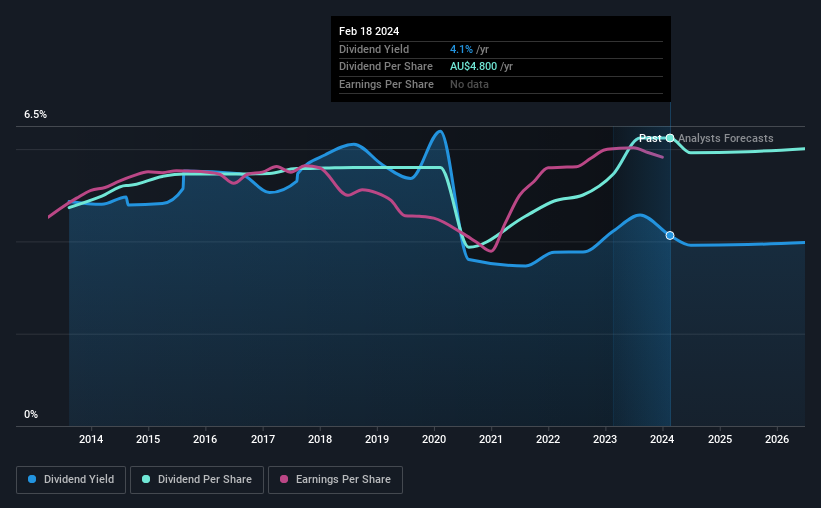Commonwealth Bank of Australia's (ASX:CBA) Dividend Will Be A$2.15
Commonwealth Bank of Australia (ASX:CBA) has announced that it will pay a dividend of A$2.15 per share on the 28th of March. This makes the dividend yield about the same as the industry average at 4.1%.
View our latest analysis for Commonwealth Bank of Australia
Commonwealth Bank of Australia's Earnings Will Easily Cover The Distributions
We like a dividend to be consistent over the long term, so checking whether it is sustainable is important.
Commonwealth Bank of Australia has established itself as a dividend paying company with over 10 years history of distributing earnings to shareholders. Taking data from its last earnings report, calculating for the company's payout ratio shows 78%, which means that Commonwealth Bank of Australia would be able to pay its last dividend without pressure on the balance sheet.
EPS is set to grow by 11.9% over the next 3 years. The future payout ratio over that same time horizon is estimated by analysts to be 79% which is a bit high but can definitely be sustainable.
Dividend Volatility
The company's dividend history has been marked by instability, with at least one cut in the last 10 years. Since 2014, the dividend has gone from A$3.64 total annually to A$4.80. This means that it has been growing its distributions at 2.8% per annum over that time. We're glad to see the dividend has risen, but with a limited rate of growth and fluctuations in the payments the total shareholder return may be limited.
The Dividend's Growth Prospects Are Limited
Given that the dividend has been cut in the past, we need to check if earnings are growing and if that might lead to stronger dividends in the future. Earnings have grown at around 3.0% a year for the past five years, which isn't massive but still better than seeing them shrink. There are exceptions, but limited earnings growth and a high payout ratio can signal that a company has reached maturity. That's fine as far as it goes, but we're less enthusiastic as this often signals that the dividend is likely to grow slower in the future.
Our Thoughts On Commonwealth Bank of Australia's Dividend
In summary, while it's always good to see the dividend being raised, we don't think Commonwealth Bank of Australia's payments are rock solid. The payments are bit high to be considered sustainable, and the track record isn't the best. We don't think Commonwealth Bank of Australia is a great stock to add to your portfolio if income is your focus.
It's important to note that companies having a consistent dividend policy will generate greater investor confidence than those having an erratic one. At the same time, there are other factors our readers should be conscious of before pouring capital into a stock. As an example, we've identified 1 warning sign for Commonwealth Bank of Australia that you should be aware of before investing. Looking for more high-yielding dividend ideas? Try our collection of strong dividend payers.
Have feedback on this article? Concerned about the content? Get in touch with us directly. Alternatively, email editorial-team (at) simplywallst.com.
This article by Simply Wall St is general in nature. We provide commentary based on historical data and analyst forecasts only using an unbiased methodology and our articles are not intended to be financial advice. It does not constitute a recommendation to buy or sell any stock, and does not take account of your objectives, or your financial situation. We aim to bring you long-term focused analysis driven by fundamental data. Note that our analysis may not factor in the latest price-sensitive company announcements or qualitative material. Simply Wall St has no position in any stocks mentioned.

 Yahoo Finance
Yahoo Finance 
